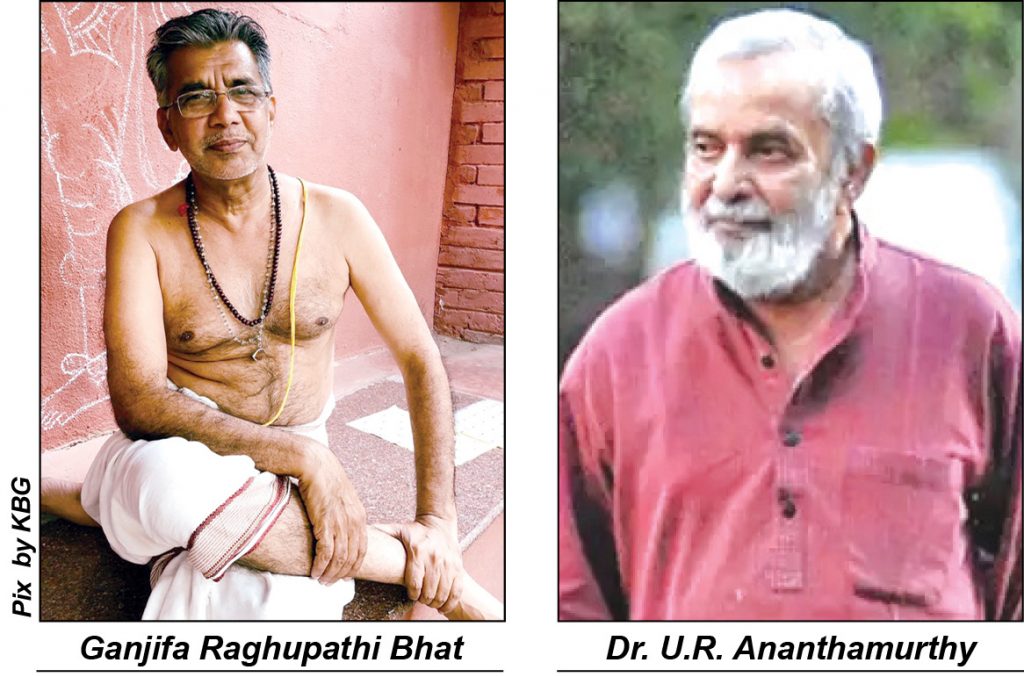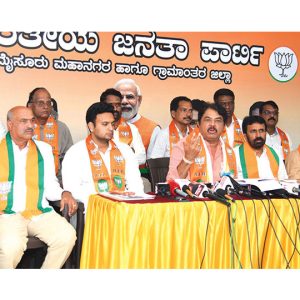Dr. U.R. Ananthamurthy’s accolades for Ganjifa Raghupathi Bhat

When I heard and read about the prestigious ‘Kalidas Samman’ award being given to our city artist Ganjifa Raghupathi Bhat, I was delighted no end. Getting awards and rewards are not rare for him. But this one is special.
When I moved my residence to an area near Lalitha Mahal Palace Hotel in Mysuru east in the new millennium 2000 AD, I chose nearby helipad for my morning walk. One morning a young man of about 40 years in jubba-pyjama with pepper and salt visage, an ashen mark on forehead followed me for a short distance, fell in step with me and then said, “Namaskara Sir, are you not Ganapathy?” in chaste Kannada.
I stopped, smiled and responded positively. Then began our walk-the-talk, getting to know each other. That day on, almost every morning we were each other’s company for morning walk. And we became friends too. He was Ganjifa Raghupathi Bhat. A fine artist famous as the reviver of an almost extinct Ganjifa art.
Later, I learnt he was also a winner of many awards, including a National award. Ganjifa is a miniature painting of Gods or calligraphy on small playing cards, either square or round in shape. It is among other two ancient Indian games played by the Kings, Mughals, rich and famous — dice and chess.
Ganjifa was a dying art when suddenly Raghupathi Bhat, after much travelling and research, revived it. Hence the name of the art, associated with the game Ganjifa, stuck to his name as a prefix.
Among the various traditional crafts of Mysuru, Ganjifa art is one of the prominent crafts patronised by the Mysore Kings. Mughal rulers, from the time of Babar, too played this card game and encouraged it. His unique style of paintings, using natural colours on hand-made paper, attracted the attention of art critics and connoisseurs as well. He has exhibited his paintings at the Victoria and Albert Museum in London and his work is in the permanent collection there. He has visited many countries in the West and also Japan on assignments or for exhibiting his paintings.
Raghupathi Bhat follows the spiritual discipline of painting as laid down in the Chitrasutra in Vishnudharmottara Purana, which is why a great number of his paintings are of Ramayana (Valmiki) and Mahabharata, inspired by Puranas and Vedas. No wonder Raghupathi Bhat’s paintings, visually mystical and mesmerising, are to be meditated upon if the viewer wants the painting to reveal its inner meaning. The painting primarily leads the viewer into the spiritual world of Sanatana Dharma. His works are certainly not of this world, mundane; they are metaphysical in form. They depict vedic images and characters from epics Ramayana and Mahabharata.
All this, I thought is a Brahmanical trait and I would taunt him about his affection for this Sudra, as I called myself while with him, during our walk-the-talk. I used to tease him a lot. Once I asked him, that as a practising Brahmin what he thought are the main characteristics of a true Brahmin. Pat came his reply. A Brahmin must have three basic virtues, he said:
1. Fasting (ಉಪವಾಸ)
2. Self-contentment (ಆತ್ಮತೃಪ್ತಿ)
3. Meditation (ಧ್ಯಾನ)
According to Bhat, fasting, self-contentment and meditation are the three core attributes of a true Brahmin and he told me he indeed practised them. Dilating on the theme, Bhat began to explain: When in dire poverty, a true Brahmin will not cheat others or steal. He would rather fast and go hungry.

Contentment with what little you have will keep you away from jealousy, greed and borrowing. That will give you peace of mind and you will even be happy.
And then meditation. Half-an-hour of meditation daily or a prayer will make you a Seeker. Seeker of ultimate truth of existence. And who knows one day, like it happened to Buddha, enlightenment may happen liberating you from all that enslaves you in this world. He guffawed.
To revert to Bhat’s art, it is said that in matters of art, only art should speak not the artist. If so let me recall here what that thinker-writer, Jnanpith award winner Dr. U.R. Ananthamurthy (late) spoke of Raghupathi Bhat’s art:
“The great thing about traditional art is it is purely functional… Now what happens in a modern set up is, we may keep the art work as a museum piece, not use it. But in a traditional home it will not be a thing to look at, it will be a thing to use and a thing to look at also. Now, when I buy traditional art, I will keep it in my showcase and not use it.
“Take for instance these Ganjifa cards. They are not just works of art, they were used for playing a game. They had a function and now I don’t think that you will revive traditional art to make it functional. It is revived purely as things to acquire and look at. But, somewhere they have to come back to their functional value also. So Bhat has that problem with those lovely cards he makes which may not be functional.
“After the Moghuls it was Hinduised, mythologised. So the traditional artists adopted something which came to the country with Moghuls and made it their own. And now, Bhat uses a lot of folk designs, so he has further changed it.
“Governments always have a role to play. I was a student in England. Shakespeare is still alive in England. Shakespeare wouldn’t be alive in England if it was left only to the market forces, because his language may not be understood by young people. There, the government has a cultural policy to preserve Shakespeare and Shakespearean theatre is subsidised. If you don’t subsidise a theatre, theatre will die. Same will be the fate of Ganjifa art if the government does not support the artist.
“So we too have to keep our traditional art alive until a day when it’s no longer a museum piece without life. I think they will come back to life if the government supports the artists.”
However, in the present world of negativity there are challenges that such artists and traditional art are made to suffer and face a slow death because our government does not play its role to save and promote the art and the artist.
[To be continued]
e-mail: [email protected]








Recent Comments